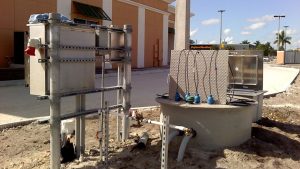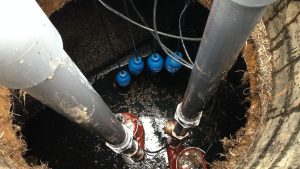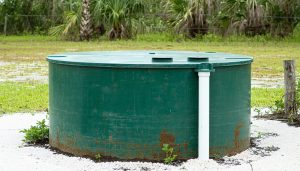In the realm of wastewater management, the selection of the appropriate pumping system is paramount for maintaining efficient operations.
Take, for example, a scenario where a municipality faces the challenge of moving sewage from a low-lying area to a higher elevation. In such cases, understanding the differences between sewage pumps and grinder pumps becomes crucial.
This article aims to provide a comprehensive comparison of these pump types, delving into their unique features, applications, limitations, and considerations. By exploring these factors, readers can make informed decisions and ensure optimal performance in their wastewater management systems.
Grinder Pumps: Not an Upgrade to Sewage Pumps
Grinder pumps should not be considered as an upgrade to sewage pumps due to their distinct differences in size, power, and functionality.
While sewage pumps are designed for low to medium head applications and can handle two-inch solids, grinder pumps are larger, heavier, and more powerful. They have a smaller discharge size, typically inch-and-a-quarter, due to their grinding capability.
Sewage pumps are ideal for pumping raw sewage, including toilet paper and human waste, while grinder pumps are suitable for uncontrolled environments where non-flushable items may be flushed.
However, it is important to note that grinder pumps have disadvantages compared to sewage pumps. They are four times more expensive, prone to clogging, and have a shorter lifespan. Careful consideration of what gets flushed and proper disposal practices are necessary to prevent damage to grinder pumps.
Sewage Pumps for Gravity-Challenged Situations
When faced with gravity-challenged situations, sewage pumps offer a reliable solution for effectively moving wastewater and sewage. In these scenarios, where traditional gravity-based systems are not feasible or practical, sewage pumps provide alternative options for pumping solutions.
Sewage pumps are designed for low to medium head applications and can handle raw sewage, including toilet paper and human waste. They are commonly used when a bathroom is below the sewer line or when pumping out to a septic tank. Equipped with a two-inch discharge, sewage pumps can efficiently transport wastewater and solids up to two inches in size.
With their ability to overcome gravity limitations, sewage pumps are a valuable tool in ensuring the proper management and disposal of wastewater in various settings.
Size and Power: Grinder Pumps Vs. Sewage Pumps
The comparison between grinder pumps and sewage pumps extends to their size and power, with each offering distinct advantages in different scenarios.
Grinder pumps are larger, heavier, and more powerful than sewage pumps, making them suitable for high head situations where pumping is required at a greater distance or height. The grinder pump’s efficiency allows it to pump further, faster, and higher, making it ideal for uncontrolled environments where non-flushable items may be flushed.
On the other hand, sewage pumps are known for their reliability and are commonly used in low to medium head applications. They are particularly effective in pumping raw sewage, including toilet paper and human waste. Sewage pumps have a two-inch discharge, while grinder pumps have a smaller discharge due to their grinding capability.
It is important to consider these size and power differences when choosing between grinder pumps and sewage pumps, taking into account factors such as cost, maintenance requirements, and the specific needs of the application.
Discharge Differences: Sewage Vs. Grinder Pumps
Sewage pumps and grinder pumps differ in the size of their discharge. Sewage pumps feature a two-inch discharge, while grinder pumps have a smaller discharge size due to their grinding capability.
This difference in discharge capacity is an important factor to consider when comparing the performance of these pumps.
Sewage pumps, with their larger discharge size, are suitable for low to medium head applications where pumping raw sewage is required. They can handle solids up to two inches in size and are commonly used in situations where gravity cannot be utilized.
On the other hand, grinder pumps have a smaller discharge size, typically around an inch-and-a-quarter, due to their grinding capability. This makes them ideal for high head situations where pumping is required over longer distances or at greater heights. They are also designed to handle non-flushable items like flushable wipes, Lysol wipes, baby wipes, and makeup remover pads.
Understanding the discharge differences between sewage and grinder pumps is crucial when selecting the appropriate pump for a specific application. By considering factors such as discharge capacity and performance comparison, users can make informed decisions to ensure efficient and effective pumping operations.
Sewage Pump Applications: Low to Medium Head
In low to medium head applications, sewage pumps are commonly utilized for efficient pumping of raw sewage, particularly in situations where gravity cannot be employed. These pumps are ideal for pumping out waste when a bathroom is located below the sewer line or when pumping to a septic tank.
One of the benefits of sewage pumps is the ability to handle solid waste up to two inches in size, thanks to the large opening between the pump and impeller. Additionally, sewage pumps have a two-inch discharge, allowing for effective and efficient transfer of sewage.
Maintenance for sewage pumps typically involves regular inspection, cleaning, and lubrication to ensure optimal performance. However, it is important to note that gravity-fed systems offer several advantages over sewage pumps, such as lower maintenance requirements and reduced energy consumption.
Grinder Pump Applications: High Head Challenges
For challenging high head situations, grinder pumps offer a powerful solution. These pumps excel in applications where pumping is required at a greater distance or height.
Here are the key benefits of using grinder pumps in high head challenges:
- Efficient Performance: Grinder pumps are designed to pump further, faster, and higher in high head situations. Their powerful motors and cutting blades allow them to effectively handle the increased resistance and pressure.
- Versatile Applications: Grinder pumps are suitable for uncontrolled environments where non-flushable items may be flushed. They can handle flushable wipes, Lysol wipes, baby wipes, and makeup remover pads, making them ideal for situations where unpredictable waste may be present.
- Smaller Discharge Size: Grinder pumps have a smaller discharge size (inch-and-a-quarter) due to their grinding capability. This enables them to efficiently move the ground-up waste through pipes and overcome the challenges posed by high head applications.
Limitations of Grinder Pumps: Cost and Maintenance
Grinder pumps, despite their efficient performance in high head challenges, come with certain limitations that need to be addressed.
One limitation is cost. Cost considerations play a significant role when choosing between grinder pumps and sewage pumps. Grinder pumps are four times more expensive than sewage pumps, making them a more substantial investment.
Another limitation is maintenance. Maintenance requirements for grinder pumps are higher compared to sewage pumps. The blades of grinder pumps can dull over time, especially when handling non-flushable items, which may lead to more frequent burnouts. Moreover, grinder pumps are prone to clogging with stringing materials, further increasing maintenance needs.
Therefore, it is crucial to carefully consider what is flushed and fed into grinder pumps to prevent damage and ensure their longevity. Understanding these limitations is essential when deciding between sewage and grinder pumps, specifically in terms of cost and maintenance requirements.
Considerations for Choosing Sewage or Grinder Pumps
When deciding between sewage and grinder pumps, it is essential to carefully evaluate the specific requirements and limitations of each option. Consider the following factors:
- Maintenance requirements: Grinder pumps have more maintenance needs compared to sewage pumps. The blades of grinder pumps can dull over time, especially if handling non-flushable items, resulting in more frequent burnouts. Additionally, grinder pumps are prone to clogging with stringing materials, which can lead to further damage.
- Cost considerations: Grinder pumps are four times more expensive than sewage pumps. This higher cost is due to their larger size, heavier construction, and more powerful capabilities. It is important to assess whether the additional features provided by grinder pumps are necessary for your specific application and worth the increased investment.
Proper Disposal Practices for Grinder Pump Longevity
To ensure the longevity of grinder pumps, it is essential to implement proper disposal practices that prevent the introduction of non-flushable items or materials that can cause clogs or damage to the pump.
Proper maintenance techniques are crucial for preventing clogs and damage to grinder pumps. One important practice is to only flush flushable items, such as toilet paper and human waste.
Non-flushable items like wipes, Lysol wipes, baby wipes, and makeup remover pads should never be flushed as they can cause clogs and damage the grinder pump blades.
It is also important to educate users about what should and should not be flushed and to provide clear instructions on proper disposal practices.
Regular inspection and cleaning of the grinder pump system can also help prevent clogs and damage.
Final Thoughts: Unleashing the Power of Sewage and Grinder Pumps
Overall, it is imperative to carefully consider the differences and applications of sewage and grinder pumps in order to harness their power effectively and make informed decisions regarding their usage.
When comparing the efficiency of these pumps, it is important to note that sewage pumps are suitable for most low to medium head applications, while grinder pumps are ideal for high head situations and uncontrolled environments.
Regular maintenance is crucial for the longevity of both types of pumps. By following proper disposal practices and avoiding the flushing of non-flushable items, the risk of clogs and damage to grinder pumps can be minimized. Additionally, regular inspections and cleaning will help ensure the optimal performance and durability of both sewage and grinder pumps.
Conclusion
At Southflls.com, we believe that understanding the nuances between different types of pumps is vital for efficient wastewater management. Our sewage pumps excellently cater to low to medium head applications, while our grinder pumps are specially designed to operate effectively in gravity-challenged situations. Both of these pump types, offered by Southflls.com, have distinct advantages and restrictions, with proper usage and maintenance being key to enhancing their lifespan.
By closely considering the unique features and applications of each pump type, Southflls.com enables customers to make informed decisions that ensure efficient and reliable wastewater management operations.
Join us at Southflls.com as we harness the power of our superior sewage and grinder pumps to address your wastewater transportation challenges.







